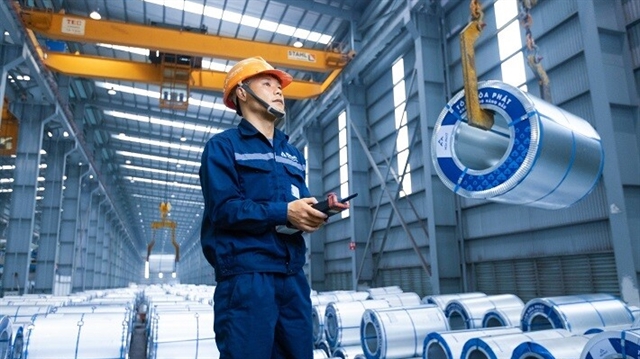 |
| A worker of Hòa Phát Group. The country’s demand for HRC steel is about 12-13 million tonnes yearly. — Photo Hòa Phát Group |
Compiled by Thanh Hải
HÀ NỘI — Hot-rolled coil (HRC) steel imports are pouring heavily into Việt Nam, while the Ministry of Industry and Trade (MoIT) is reviewing domestic enterprises’ dossiers requesting an anti-dumping investigation on HRC steel products imported from China and India.
In June 2024 alone, Việt Nam imported 886,000 tonnes of HRC steel, equal to 151 per cent of domestic production, of which the amount of steel imported from China accounted for 77 per cent.
The amount of imported HRC steel in the first six months of this year increased sharply to an alarming level, 1.7 times higher than domestic production.
In particular, the import activity is still vibrant, even when the MoIT officially received dossiers from domestic businesses requesting an anti-dumping investigation on HRC steel imported from China and India on June 14.
Cumulatively in the first six months of 2024, imported HRC steel output reached nearly six million tonnes, up 32 per cent over the same period in 2023. This import volume is equal to 173 per cent of domestic production. Of which, the amount of steel imported from China accounts for 74 per cent, the remaining is from Taiwan, Korea, India, Japan and other countries.
HRC steel import turnover in six months reached US$3.46 billion, with China alone accounting for $2.5 billion. Notably, HRC steel products imported from China have very low prices, an average of $560 /tonne, $45 to $108 /tonne lower than other countries.
According to regulations, the MoIT will have 45 days to review before making a final decision, from the date of officially receiving the complete dossier.
The massive influx of cheap imported goods showing signs of dumping into Việt Nam prevents domestic enterprises from exploiting their full design capacity.
According to the Vietnam Steel Association (VSA), the country’s demand for HRC steel is about 12-13 million tonnes a year.
The capacity of domestic HRC steel factories is currently about nine million tonnes. Therefore, the massive import of steel flooded into Việt Nam was nearly double the domestic production, dominating the HRC steel market share of domestic enterprises.
The market share of HRC steel sales of domestic enterprises such as Hòa Phát and Formosa has decreased from 42 per cent in 2021 to 30 per cent in 2023.
At the General Meeting of Shareholders in April, Chairman of the Board of Directors of Hòa Phát Group Trần Đình Long said: “No country in the world allows imported goods in larger quantities than domestic production. In 2023, HRC steel production of Hòa Phát and Formosa was 6.7 million tonnes while HRC steel imports were 9.6 million tonnes. Massive imports will sooner or later crush domestic production.”
Director of the WTO and Integration Centre (VCCI) Nguyễn Thị Thu Trang said that in the International Trade Organisation (WTO), steel is the group that applies the most trade defence measures, accounting for 32 per cent of trade defence cases in the period 1995-2023. The reason why steel is of such interest is because of the importance of this product in the development and construction process of countries.
Meanwhile, Việt Nam’s HRC steel production capacity has met 70 per cent of the country’s consumption demand (8.5/12 million tonnes), but there currently are no preferential rates for countries with normal trade relations status with Việt Nam and no other tariff barriers to protect domestic production. This makes the Vietnamese market a low-lying area for imports from neighbouring countries and can be exploited by steel powers to export to European and American markets.
Steel industry experts also said that Việt Nam’s steel industry, especially high-quality and HRC steel production is quite disadvantaged because international agreements and commitments have a tax rate of zero per cent due to the context previously steel has not been produced domestically.
In recent years, Việt Nam’s steel industry has made strong developments, becoming self-sufficient in many high-quality products, especially HRC steel. Việt Nam is reaching the leading position in Southeast Asia in steel production and ranks in the top 12 largest steel-producing countries in the world. Therefore, the government, ministries and branches need to take timely measures to protect the domestic production of upstream products.
Ms. Nguyễn Thị Xuân Thúy, a lecturer at the University of Economics (Hanoi National University), said that the Government of Việt Nam always encouraged improving domestic production capacity and developing foundation and materials industries in which steel is the input material product of many different production chains.
“Being proactive in domestic supply not only contributes to increasing the autonomy of the economy but also enhances domestic added values, enhancing Việt Nam’s position in the global value chain, so an anti-dumping investigation on imported HRC steels, ensuring a fair competitive environment and creating favourable conditions for domestic manufacturing enterprises is necessary,” said Thúy. — VNS
- Reduce Hair Loss with PURA D’OR Gold Label Shampoo
- Castor Oil Has Made a “Huge” Difference With Hair and Brow Growth
- Excessive hair loss in men: Signs of illness that cannot be subjective
- Dịch Vụ SEO Website ở Los Angeles, CA: đưa trang web doanh nghiệp bạn lên top Google
- Nails Salon Sierra Madre
 VnExpress News The News Gateway of Vietnam
VnExpress News The News Gateway of Vietnam




